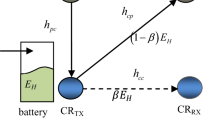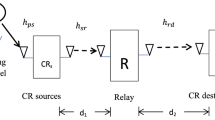Abstract
In this paper, a hybrid spectrum access scheme is investigated for a relay based energy harvesting cooperative cognitive radio (CR) network. In the considered network model, a relay harvests energy from RF signal of primary user (PU) as well as from RF signal of CR also. The relay node forwards the CR data to the respective destination and also cooperates in PU transmission as well. The CR follows a hybrid spectrum access scheme, i.e., it employs an underlay scheme of co-existence if PU is found to be present in the given channel else it switches to the overlay scheme of transmission. In overlay scheme, a CR transmits with maximum transmission power while in underlay scheme, it controls its transmission power based on the knowledge of channel state information of the link between CR and PU receiver, to limit the interference at PU receiver. Three new ratio parameters namely, PU–CR time allocation parameter, PU two hop transmission parameter and CR two hop transmission parameter are considered to model the cooperative transmission of PU and CR network where the parameter β takes care of the allocated time for PU and CR transmission and the other two parameters θ and ϕ take care of two hop transmission for PU and CR respectively. Analytical expressions of combined throughput of a CR and PU are developed under the considered network scenario. The performance is investigated in terms of combined throughput of CR, combined throughput of PU, and the overall network throughput for several sensing parameter and new ratio parameters.










Similar content being viewed by others
References
Digham, F. F., Alouini, M.-S. & Simon, M. K. (2003). On the energy detection of unknown signals over fading channels. In Proceedings of the of IEEE international conference on communications (pp. 3575–3579).
Ghasemi, A., & Sousa, E. S. (2005). Collaborative spectrum sensing for opportunistic access in fading environments. In Proceedings of 1st IEEE Symposium on new frontiers in dynamic spectrum access networks, Baltimore, USA (pp. 131–136).
Sharma, V., Mukherji, U., Joseph, V., & Gupta, S. (2010). Optimal energy management policies for energy harvesting sensor nodes. IEEE Transactions on Wireless Communications, 9(4), 1326–1336.
Mitola, J., & Maguire, G. Q. (1999). Cognitive radio: Making software radios more personal. IEEE Pres. Commun., 6, 13–18.
Bagwari, A., & Tomar, G. S. (2013). Cooperative spectrum sensing with adaptive double-threshold based energy detector in cognitive radio networks. Wireless Personal Communications, Springer An International Journal, 70(4), 1–15.
Bagwari, A., Tomar, G. S., & Verma, S. (2014). Cooperative spectrum sensing based on two-stage detectors with multiple energy detectors and adaptive double-threshold in cognitive radio networks. IEEE Canadian Journal of Electrical and Computer Engineering, 36(4), 172–180.
Bagwari, A., & Tomar, G. S. (2013). Two-stage detectors with multiple energy detectors and adaptive double threshold in cognitive radio networks. International Journal of Distributed Sensor Networks, Hindawi Publishing Corporation, 9(8), 1–8.
Singh, Ajay, Bhatnagar, Manav R., & Mallik, Ranjan K. (2012). Cooperative spectrum sensing in multiple antenna based cognitive radio network using an improved energy detector. IEEE Communications Letters, 16(1), 64–67.
Singh, A., Bhatnagar, M. R., & Mallik, R. K. (2011). Optimization of cooperative spectrum sensing with an improved energy detector over imperfect reporting channels. In Vehicular technology conference (VTC Fall) 2011 IEEE (pp. 1–5). IEEE.
Singh, Ajay, Bhatnagar, Manav R., & Mallik, Ranjan K. (2013). Threshold optimization of a finite sample-based cognitive radio network using energy detector. EURASIP Journal on Wireless Communications and Networking, 2013(1), 165.
Singh, A., Bhatnagar, M. R., & Mallik, R. K. (2012). Threshold optimization of finite sample based cognitive radio network. In National Conference on Communications (NCC), 2012 (pp. 1–5). IEEE.
Bagwari, A. & Singh, B. (2012). Comparative performance evaluation of spectrum sensing techniques for cognitive radio networks. In 4th International conference on computational intelligence and communication networks (CICN), 2012 (pp. 98–105). IEEE.
El Shafie, A., Ashour, M., Khattab, T., & Mohamed A. (2015). On spectrum sharing between energy harvesting cognitive radio users and primary users. In 2015 International conference on computing, networking and communications (ICNC) (pp. 214–220) Garden Grove, CA: IEEE.
Liang, Y.-C., Zeng, Y., Peh, C. Y., & Hoang, A. T. (2008). Sensing-throughput tradeoff for cognitive radio network. IEEE Transactions on Wireless Communications, 7(4), 1326–1337.
Chen, X., Jing, T., Huo, Y., Li, W., Cheng, X., & Chen, T. (2012). Achievable transmission capacity of cognitive radio network with cooperative relaying. In Proceedings of the IEEE CROWNCOM, Stockholm, Sweden (pp. 1–6).
Song, Hojin, Hong, Jun-Pyo, & Choi, Wan. (2013). On the optimal switching probability for a hybrid cognitive radio system. IEEE Transactions on Wireless Communications, 12(4), 1594–1605.
Tan, Xiaobo, Zhang, Hang, & Jian, Hu. (2013). Achievable transmission rate of the secondary user in cognitive radio networks with hybrid spectrum access strategy. IEEE Commns. Letters, 17(11), 2088–2091.
El Shafie, A., & Khattab, T. (2014). Maximum throughput of a cooperative energy harvesting cognitive radio user. In IEEE 25th annual international symposium on personal, indoor, and mobile radio communication (PIMRC). IEEE.
Nasir, A. A., Xiangyun, Z., Salman, D., Kennedy, R. A. (2014). Throughput and ergodic capacity of wireless energy harvesting based DF relaying network. In Proceedings IEEE international conference on communications (ICC’14), Sydney, NSW (pp. 4066–4071).
Vu-Van, H., & Koo, I. (2014). Optimal throughput for cognitive radio with energy harvesting in fading wireless channel. The Scientific World Journal, 2014, 1–7.
Muhammad, U., & Insoo, K. (2014). Access strategy for hybrid underlay overlay cognitive radio with energy harvesting. IEEE Sensors Journal, 14(9), 3164–3173.
Shi, Z., Teah, K. C., & Li, K. H. (2013). Energy efficient joint design of sensing and transmission durations for protection of primary user in cognitive radio systems. IEEE Communications Letters, 17(3), 565–568.
Prasad, B., Roy, S. D., & Kundu, S. (2014) Outage and SEP of secondary user with imperfect channel estimation and primary user interference. In Proceedings of the IEEE CONECCT (pp. 1).
Author information
Authors and Affiliations
Corresponding author
Rights and permissions
About this article
Cite this article
Das, G.C., Prasad, B., Bhowmick, A. et al. Performance of an Energy harvesting Cooperative Cognitive Radio Network with Hybrid Spectrum Access Scheme. Wireless Pers Commun 99, 1503–1520 (2018). https://doi.org/10.1007/s11277-018-5289-1
Published:
Issue Date:
DOI: https://doi.org/10.1007/s11277-018-5289-1




